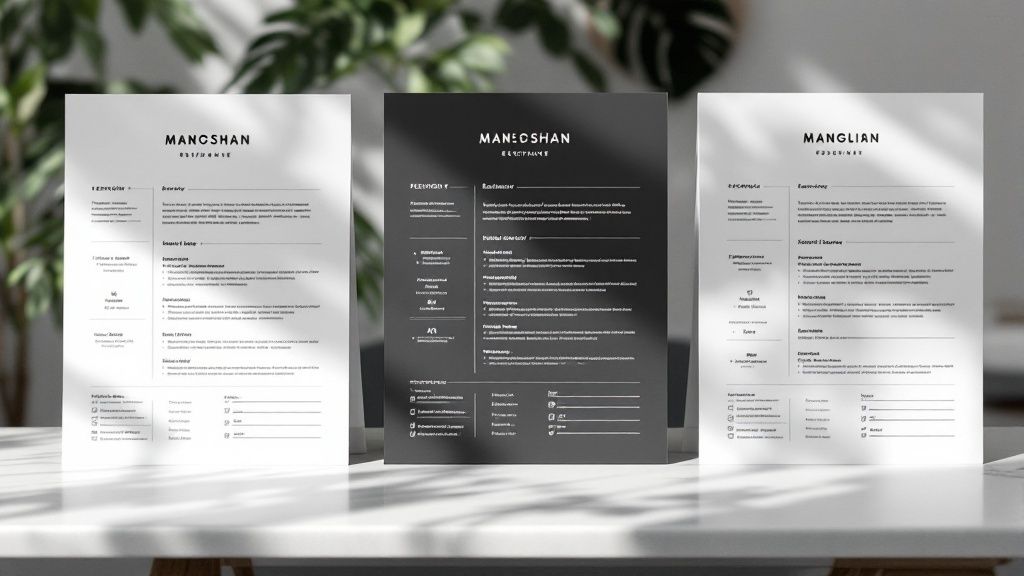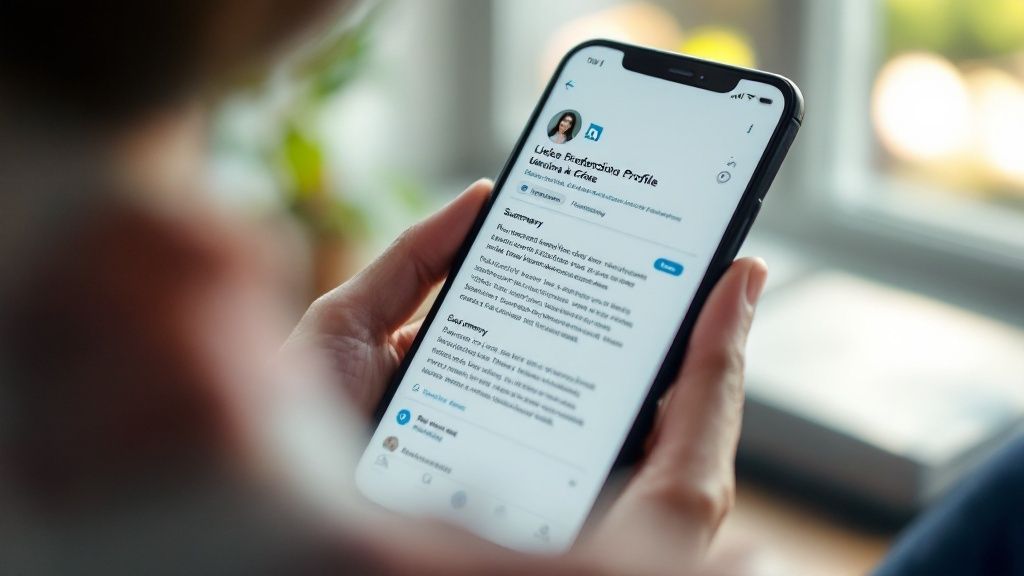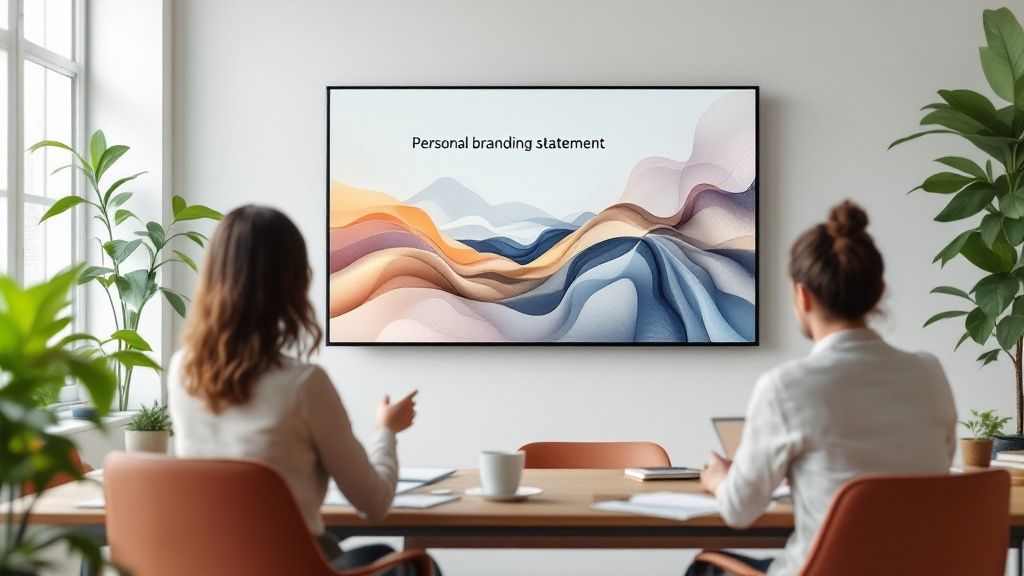
25 Powerful Personal Branding Statement Examples That Will Inspire You
Last updated: April 20, 2025
Understanding Personal Branding Statements: Your Professional Story
A personal branding statement is the heart of how you present yourself professionally. It captures your core identity, expertise, and the unique value you bring. Think of it as both your elevator pitch and the foundation of your professional reputation. When done well, it helps you stand out and makes a memorable impression.
Why a Strong Personal Brand Statement Matters
A clear personal brand statement helps you connect with the right people. It communicates your value in a way that resonates with potential clients, employers or collaborators. Good brand statements build trust by showing exactly what you can do. Consider how much more likely you are to remember and connect with someone who can articulate their value clearly and confidently.
Your brand statement also acts as your professional compass. It keeps you aligned with your strengths and guides you toward opportunities that fit your goals. Just as companies use mission statements to stay focused, your personal brand statement helps ensure your career moves match your aspirations.
The Psychology of Effective Branding
Research demonstrates the real impact of personal branding on career success. Studies show that 69% of reviewed papers highlighted how personal branding advances careers, while 78% noted its role in building influence and professional status. Learn more about the research here. A strong personal brand statement isn’t just words – it’s a tool that can shape your career path by making you memorable and establishing your expertise.
Crafting a Statement that Resonates
Creating an effective personal brand statement starts with self-reflection and understanding your audience. Consider these key questions:
- What are my core skills and strengths?
- What problems do I solve for others?
- What makes me unique in my field?
- What do I want to be known for?
Your answers will form the core of your statement. For example, if you’re a software engineer working in AI, focus on how you create AI solutions that boost business results. Or as a graphic designer focused on sustainability, emphasize how you blend visual appeal with environmental responsibility.
By defining your unique strengths and target audience clearly, your personal brand statement becomes more than just words – it becomes a powerful tool for achieving your professional goals. This understanding sets the foundation for examining real examples of successful personal brand statements, which we’ll explore next.
Learning From the Masters: Industry Leaders’ Brand Statements
Looking at successful personal branding statements shows us what works and what doesn’t. These real-world examples reveal how top professionals sum up their value in clear, memorable ways. Let’s break down why these statements work so well.
Deconstructing Powerful Personal Brand Statements
Here are some standout examples from well-known figures:
- Seth Godin: As an author, blogger and entrepreneur, Godin keeps things remarkably simple. He calls himself a “teacher” and someone who “works on things.” While this may seem basic, it carries weight because of his track record – including 19 bestselling books and many popular courses. Learn more about personal brand statements.
- Brene Brown: As a research professor and bestselling author, Brown focuses squarely on vulnerability, courage and shame-resilience. While she doesn’t have one explicit brand statement, her message of helping people live authentically runs through all her work.
- Gary Vaynerchuk: This entrepreneur and social media expert sums up his philosophy with “Legacy is greater than currency.” This simple statement shows his focus on long-term impact over quick wins.
Key Takeaways From the Masters
These examples highlight several important principles:
- Clarity: Each person communicates their focus without confusion or jargon
- Authenticity: The statements match who they really are and what they truly value
- Conciseness: They keep it short and memorable, making their message easy to share
Applying These Lessons to Your Own Brand
To create your own strong brand statement, start with the basics: What are you great at? What problems do you solve? What makes you different? Take these core elements and craft them into a clear, genuine statement that reflects your values.
Adapting Your Statement Over Time
Your brand statement should grow as you do. Consider updating it when:
- Career Changes: Like moving from marketing to product management
- New Skills: Such as learning a new programming language
- Industry Changes: As your field evolves with new technology and trends
The key is staying true to yourself while showing your growth and current expertise. Regular reviews help ensure your statement still fits who you are and where you’re headed.
By studying these examples and understanding what makes them work, you can create a statement that shows your unique value. Remember to check and update it regularly so it keeps pace with your career growth.

Crafting Your Signature Statement: A Strategic Approach

A compelling personal branding statement captures who you are and the value you bring. It’s not about following a template – it’s about understanding yourself and connecting with your audience. Let’s explore how to create a statement that truly represents you.
Uncovering Your Unique Value Proposition
Start by identifying what makes you stand out. Look beyond your basic qualifications and think about the real results you deliver. Do you help teams hit ambitious targets? Do you make complex problems simple? Focus on specific, measurable ways you create positive change for others.
Defining Your Target Audience
Your statement needs to speak directly to the people you want to reach. Are you aiming to connect with startup founders? Fortune 500 executives? Industry colleagues? Understanding their challenges and goals will help you craft a message that hits home.
Integrating Self-Assessment With Market Research
Creating an effective statement requires both honest self-reflection and market understanding. Ask trusted colleagues for candid feedback about your strengths. Research your industry to identify what skills and expertise are most valuable. This combination helps you develop a statement that rings true while meeting market needs. Learn more about building your personal brand from the Harvard Business Review.
Structuring Your Statement for Maximum Impact
Keep your statement brief, memorable and focused on action. A simple format to follow: “I help [audience] achieve [outcome] through [your approach].” This structure clearly shows who you serve and how you create value.
Examples of Effective Personal Branding Statements
Here are some examples that show how to target specific audiences:
- “I help tech startups secure funding by creating compelling investor pitches” – For startup founders
- “I guide CEOs to strengthen their leadership through personalized coaching” – For C-suite executives
- “I advance software development by building practical AI solutions” – For tech leaders
Notice how each statement is specific about the audience, outcome, and method.
Refining Your Statement Through Iteration
Your statement should grow with your career. Review and update it regularly based on new accomplishments, feedback, and professional goals. Regular refinement ensures your statement stays authentic and effective as you evolve.
Evolving Your Brand Statement Through Career Transitions

As you progress in your career, your personal brand statement needs to grow and adapt. Like the successful industry leaders discussed earlier, your statement must accurately reflect your current abilities, aspirations, and intended audience. Regular updates ensure your personal brand statement stays meaningful and impactful.
Adapting Your Message to New Roles and Responsibilities
When you change roles, your responsibilities and expertise naturally shift. Take the example of moving from software development to project management – your personal brand statement should now emphasize your leadership capabilities and project oversight skills rather than just technical coding abilities. This focused messaging helps establish your credibility in the new position.
Maintaining Authenticity While Embracing Change
As you update your brand statement, stay true to who you are at your core. Your personal brand reflects your professional identity, and genuine authenticity builds lasting trust. While specific skills may change, keep your fundamental values consistent. For example, if creativity drives your work approach, make sure it shines through in your updated statement, regardless of your new role.
Personal Branding Statement Examples: From Entry-Level to Executive
Here are real-world examples across career stages:
- Entry-Level Marketing Specialist: “I help businesses connect with their target audience through creative social media campaigns.”
- Mid-Level Marketing Manager: “I lead marketing teams to develop and execute strategies that drive brand growth and customer engagement.”
- Senior Marketing Director: “I develop and implement marketing strategies that boost market share and profitability for leading brands.”
These examples show how messaging naturally progresses to reflect growing responsibility and expertise. Each statement builds on previous experience while demonstrating clear career growth.
Signaling Readiness for Advancement
A well-written personal brand statement can effectively communicate your career goals. By highlighting your key achievements and future aspirations, you position yourself for new opportunities. Showing your dedication to growth and skill development makes you valuable to potential employers and clients.
Avoiding the Common Pitfalls of Personal Branding
Building a memorable personal brand requires careful attention to avoid common mistakes that can weaken your message. Let’s explore some key pitfalls and how to sidestep them while creating a personal brand that truly connects with your audience.
Finding the Balance Between Confidence and Humility
One of the biggest challenges is striking the right tone when talking about your abilities. Instead of making sweeping claims like “I’m the best at tech innovation,” focus on sharing specific examples of how your skills have helped teams achieve results. This approach shows confidence grounded in real accomplishments while leaving room for continued growth and learning.
Steering Clear of Industry Jargon
While technical terms have their place, overusing industry jargon can make your message hard to understand. For example, rather than saying “I enhance UX/UI synergy,” try “I help make websites easier and more enjoyable to use.” This clear, simple language helps you connect with people both inside and outside your field.
Authenticity Over Imitation
Your personal brand should reflect who you really are, not who you think you should be. Share your genuine experiences, values and perspective rather than copying others’ styles – even if they’re successful in your industry. When you stay true to yourself, your message naturally resonates with the right people.
Practical Exercises for Refinement
Here are some hands-on ways to strengthen your personal brand:
- Get honest feedback from trusted colleagues and mentors
- Test your message with a small group from your target audience
- Review all your profiles to ensure your brand is consistent across platforms
Remember to stay open to constructive criticism and regularly refine your message based on what you learn. This ongoing process helps create an authentic personal brand that truly represents you and connects with others in a meaningful way.
Measuring and Optimizing Your Brand Statement’s Impact

Your personal branding statement needs regular evaluation and updates to stay effective. Think of it as a living document that grows with your career. Let’s explore practical ways to measure its impact and make it even better over time.
Gathering Feedback From Diverse Sources
Get honest input about your branding statement from different perspectives. Reach out to colleagues, mentors, and clients for their thoughts. Consider using quick online surveys to collect anonymous feedback from others in your field. This variety of viewpoints helps you spot blind spots and opportunities for improvement.
Interpreting Engagement Metrics
Look at how people respond to your branding statement across different platforms. On LinkedIn, track key numbers like profile visits, connection requests, and post engagement. These metrics tell you which parts of your message resonate most with readers. For example, if you notice more people reaching out after you update your statement, you’re probably on the right track.
A/B Testing for Optimization
Try testing two versions of your branding statement to see which works better. Make small changes in wording or emphasis between the versions. Use them at networking events or on different online platforms. Keep track of which version gets better responses and use those insights to improve your message. This hands-on testing helps you find the most impactful way to present yourself.
Tools and Frameworks for Ongoing Evaluation
Simple tools can help you assess your branding statement’s effectiveness. Use brand audit checklists to check if your message stays consistent across platforms. Try feedback tools that let people share honest thoughts anonymously. These resources help you make smart updates based on real responses rather than guesswork.
Are you ready to build a stronger personal brand? Bhavik Sarkhedi helps founders, CEOs, and entrepreneurs create lasting impact through expert personal branding and content strategy. Visit the website to learn how we can help showcase your professional strengths.

